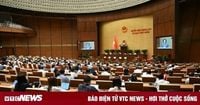On June 12, 2025, Vietnam's National Assembly marked a historic milestone by approving a sweeping rearrangement of its provincial-level administrative units, a move set to reshape the country's political and economic landscape. With an overwhelming majority of 461 out of 465 delegates voting in favor, the Assembly passed a Resolution that consolidates the existing 63 provinces and centrally governed cities into 34 units—comprising 28 provinces and 6 centrally-run cities. This significant reform, effective immediately from the date of approval, represents a revolutionary overhaul of the nation’s administrative structure.
The Government had initially presented this ambitious plan on June 11, 2025, proposing to merge 52 provincial-level units—including 4 centrally-run cities and 48 provinces—into 23 new provincial entities. Eleven units, including Hanoi, Hue, and Cao Bang (the latter due to special considerations despite not meeting standard criteria), will remain unchanged. The rearrangement aligns with key directives from the Politburo and the Central Committee, particularly Resolution No. 60-NQ/TW issued on April 12, 2025, underscoring the political will behind this transformative initiative.
Minister of Home Affairs Pham Thi Thanh Tra emphasized the comprehensive nature of this reform. "This period is a historic and revolutionary moment for national administration," she said during the presentation. The Government’s approach was not simply to merge adjacent provinces but to meticulously consider natural territorial forms, population size, historical and cultural factors, ethnic and religious diversity, and socio-economic development visions. A particular focus was placed on leveraging coastal access to foster large economic centers, enhancing regional integration and competitiveness both nationally and internationally.
Among the notable mergers are the consolidation of Ha Giang and Tuyen Quang into the new Tuyen Quang province, with a land area of 13,795.50 square kilometers and a population of approximately 1.86 million. Similarly, Yen Bai and Lao Cai provinces will unite as Lao Cai province, covering 13,256.92 square kilometers and hosting nearly 1.78 million residents. Other significant combinations include the merging of the centrally-run city of Hai Phong with Hai Duong province, forming a new Hai Phong city entity encompassing 3,194.72 square kilometers and over 4.66 million people. The merger of Ho Chi Minh City with Ba Ria - Vung Tau and Binh Duong provinces creates a mega-city with a population exceeding 14 million, covering 6,772.59 square kilometers.
These new administrative units comply fully with the standards set forth in Resolution No. 1211/2016/UBTVQH13 and Resolution No. 76/2025/UBTVQH15, ensuring that each meets the required natural area and population thresholds. The rearrangement is expected to rationalize governance, reduce bureaucratic layers, and create stronger economic development spaces that capitalize on the complementary strengths of mountainous, coastal, and urban regions.
Deputy Prime Minister Nguyen Hoa Binh described the reform as "a revolution in organizational structure and personnel," highlighting its role in streamlining the government apparatus by reducing one intermediate administrative level. He noted that this restructuring aims to build a more logical framework and generate robust economic zones that blend the advantages of diverse regions. The Deputy Prime Minister further detailed the transition timeline: on June 30, 2025, all provinces will simultaneously announce their new administrative boundaries and leadership teams, including both Party and governmental officials. The new two-tier local government model—comprising provincial and communal levels—will officially begin operation on July 1, 2025.
Minister Pham Thi Thanh Tra underscored the exhaustive preparations undertaken across all levels of government. The Politburo, Central Committee, and Government have coordinated efforts to ensure readiness for this unprecedented administrative transformation. Local authorities have actively engaged in planning and implementing the new governance structures, with an eye towards sustainable development and enhanced public service delivery.
Public support for the rearrangement has been notably strong. Surveys indicate an average approval rate of 96.19% nationwide, with unanimous support from People's Councils at provincial, district, and communal levels within the 52 provinces and cities involved in the merger. This widespread consensus reflects a shared recognition of the reform's necessity and potential benefits.
From a personnel standpoint, the rearrangement will affect a total of 447,657 staff members across the 52 merging provinces and cities, including 2,321 cadres, 79,118 civil servants, and 366,218 public employees. The Government has outlined clear principles for the reassignment and management of these officials to ensure a smooth transition. Notably, Deputy Prime Minister Nguyen Hoa Binh clarified that the process will not involve an immediate wholesale transfer of all personnel from old to new units. Instead, a phased approach will allow some staff to remain temporarily to support initial operations and address outstanding projects and local issues.
Regarding infrastructure, the provinces and cities currently maintain 38,182 public office buildings. Post-merger, 33,956 of these will continue in use, while 4,226 are projected to become surplus. The Government has committed to managing these assets in accordance with regulations and will provide guidance on financial and operational matters associated with the transition.
The National Assembly has tasked the Government, provincial People's Councils, and People's Committees with supporting affected officials and employees, ensuring social welfare, protecting legitimate rights, and maintaining economic, social, defense, and security stability during the transition. Furthermore, the Government is responsible for verifying and updating the precise boundaries and natural areas of the new administrative units, with provisions to publicly disclose any adjustments without requiring further Assembly approval.
This comprehensive reform also anticipates a significant reduction in the size of the local government workforce. Estimates suggest a decrease of approximately 250,000 personnel, including 130,000 cadres, civil servants, and public employees, alongside 120,000 non-specialized communal-level workers. Financially, the reform is projected to save over 190 trillion Vietnamese dong during the 2026-2030 period, reflecting increased efficiency and streamlined administration.
As the new administrative units prepare to take shape, the National Assembly’s Resolution mandates that local governments in pre-merger provinces and cities continue functioning until the newly formed entities officially commence operations on July 1, 2025. This transitional arrangement aims to ensure continuity in governance and public services.
In sum, Vietnam’s bold administrative restructuring represents a landmark decision with far-reaching implications. By consolidating provincial units and adopting a streamlined two-tier governance model, the country aims to foster stronger economic hubs, optimize resource allocation, and enhance administrative efficiency. As the new provincial and city governments gear up to begin operations, all eyes will be on how this ambitious reform unfolds in practice, potentially setting a new course for Vietnam’s development in the decades ahead.



